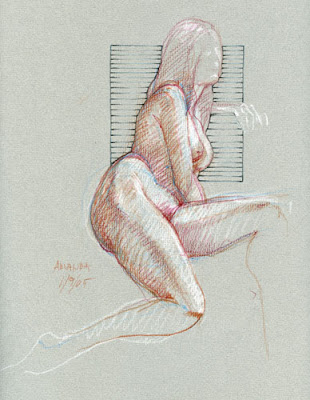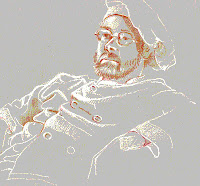Several of my ex-students whose first digital steps were taken on the Amiga are now well established at companies like Disney, Activision and Electronic Arts. Another helms one of the most successful animation studios serving New York's advertising industry. Some work for themselves in smaller commercial endeavers while others are full time painters making a wonderful living with their work (or not!) There are photographers, print makers, fabric designers, advertising designers I want to make note of all those who have become teachers too, whether public school art teachers or college professors in, out or beyond the realms of art. There are so many, some I'm likely not aware of. They may have no paintings to display here but they've chosen an honorable, important profession. Hats off to all! (My apologies to any I may have forgotten. Bound to be some!)
One aspect of teaching that can be both a delight and a challenge is accomodating individual talents and interests while imparting fundamentals in areas such as design, drawing, color and craft. It means working with each student on a daily and long term basis - making suggestions, showing relevant examples, pointing out strengths and weaknesses, - gaining trust by demonstrating solutions without stepping on students' unique visions. The rewards are graduates confident in their own abilities and proud of work which reflects personal concepts and individual solutions. The ultimate reward of course, is to see those young people, your students, move on out into fields where they find success building on those fundamentals.
A very important is the solid satisfaction I've had with students in general. After all, not everyone is a star, but while not all are destined for fame, each are worth attention, time and effort. There were quite a few who just couldn't get it together in high school but have found real success a life doing something they find truly interesting (art related or not), making good families, raising strong children. I run into them everywhere: Picnicking in a park two states away, talking to telephone reps for large companies as they ask, "Are you the Phil Spaziani who...?", Surgical nurses greeting me as I'm lifted onto the table! There are those who send holiday greetings from Montana mountain dirt roads, London Close homes, expensive NYCity apartments, small flats in San Francisco, cards from Mexico's Day of the Dead celebrations and these days posts by the dozens on FaceBook. Thanks!
A special thanks to all those great students who with their enthusiasm and interest helped make my teaching career so happily successful. Another to those who have followed this blog over the past few years with encouraging comments and reflections.
Now, it's break time - time to re-charge. I'll be back.
"When one teaches, two learn." Robert Half
A special thanks to all those great students who with their enthusiasm and interest helped make my teaching career so happily successful. Another to those who have followed this blog over the past few years with encouraging comments and reflections.
Now, it's break time - time to re-charge. I'll be back.
"When one teaches, two learn." Robert Half



















































